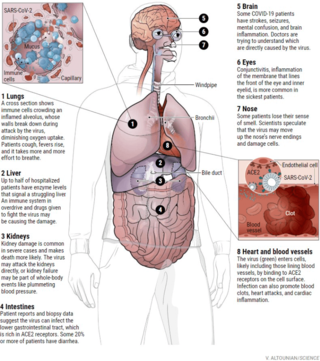Coronavirus Disease 2019
COVID-19: Updated Psychiatric and Physical Understandings
Part 2: The psychological and physiological interactions in COVID-19.
Posted June 14, 2020 Reviewed by Abigail Fagan
This post is Part 2 in a series. Click here to read Part 1.
The early COVID-19 symptoms of loss of taste and smell reflect that we breathe in the virus through our nose (and even our mouth), where the highest concentration of ACE-2 receptors exists, as well as odor receptors. Similarly, taste buds are located on the front and back of the tongue, soft palate, upper esophagus, etc. and would be exposed early by breathing, even while eating.
Pertinently, children (4-9 years) who have the lowest rates of SARS-COV-19 infection also have the lowest expression of ACE-2 in their nasal epithelium. Moreover, this expression increased with each age group 10-17, 18-24, and 25-60 years, respectively, in an age-dependent manner. (11, 12) This may be one aspect of infection susceptibility along with the pivotal role of our mitochondria, the powerhouse of our cells and body, which COVID-19 attacks and incapacitates. This will be discussed in Part 3 since the immune system cannot function properly without its intact mitochondria.

1. The lungs — These act essentially as a very fragile air filter, whose greatest vulnerability is a single layer of cells with a high concentration of ACE-2 receptors, in the shape of a tiny bubble or alveolus surrounded by a web of blood vessels.
5. The brain — Besides strokes, seizures, and mental confusion, past studies of SARS COV infections described visual and auditory hallucinations, depression, and manic disorders. Coronavirus RNA has been found in the autopsied brains of SARS patients and in those with multiple sclerosis. Serological immune assays specific for four different non-SARS human coronaviruses were antibody immunoglobulin (IgG) assessed in 106 voluntary patients with recent onset of psychotic symptoms, including those with bipolar disorder and major depression. Coronavirus seropositivity and antibody levels were increased with both mood and especially with schizophrenia-spectrum disorder diagnoses (4).
6. The eyes — Surrounding tissues, such as the inner eyelid, have ACE-2 receptors that are directly exposed to virus-filled air droplets.
7. The nose — The nose is the first air filter and the first line of immune defense, including coryza. If that fails, the virus can pass down the nasopharynx to the lungs, where the interface of air, virus, and our blood supply in our alveoli can allow COVID-19 along with any tiny clots to spread throughout the body.
COVID-19 spike protein binds ACE-2, and in concert with host (our) proteases (an enzyme which breaks down protein), principally TMPRSS2, promotes cellular entry” or infection. (5) The virus can then hijack the cells' machinery to multiply and infect new cells. Though interferons are produced by our body as antiviral substances, giving us protection while minimizing adverse effects or pathology, they can also be hijacked by COVID-19 to increase the production of ACE-2 “in human nasal epithelia and lung tissues”… “to enhance infection”(5) or a “double whammy.”
8. Heart and blood vessels — “Many doctors now recognize clotting as a major feature of severe COVID-19.” Dr. E’na Marcia Negri, a Brazilian pulmonologist, developed this idea after treating a woman whose breathing troubles coincided with circulatory problems in her toes. Negri’s team gave the woman heparin, a common blood thinner, and not only her toes but also her breathing recovered. (6)
An associated marker is our blood platelets directly involved in clotting (stopping bleeding), and when low, we bruise easily or bleed. Italian researchers (7) found that low platelets, because of more clotting, are associated with severe COVID-19 infection and mortality.
Prothrombin is a protein in the blood, which, when activated, becomes thrombin, a clotting promoter. It converts fibrinogen to fibrin, which leads to the formation of a clot. Viral host cell proteases in mammals have been found responsible for the activation and spread of various animal viruses. (8) A protease was found in viral studies of chick embryo essentially identical to blood clotting factor x, a member of the prothrombin family,(8) also found in humans, which may play a role in COVID-19.
Fear of and anxiety over the COVID-19 invisible illness to which you may be unknowingly exposed or may be carried by you have to some extent distracted us from various forms of financial and job insecurity, hunger, housing, unemployment, etc. For the elderly, social distancing can become sensory deprivation called loneliness, disconnectedness, and isolation. The latter apparently contributed to a surge in suicides among older adults in Hong Kong during the SARS-CoV epidemic in 2003. (9) If history is useful, another surge of reported depression, anxiety, and PTSD is forthcoming. Calling older family members, friends, and neighbors to say hello and inquire about their well-being can help their mental health.
Social distancing is in direct conflict with human nature. We crave physical and emotional connection with friends and family who want to hug and touch each other. Touch is essential for our emotional survival, especially for children. (10)
This is observed in the trauma of not being able to have the last touch with those who are dying. Or watching children putting their hands in mirror fashion against the windows of their parents' nursing or assisted living rooms. We need to be touched and hugged as much as our pets since it fortifies us to live. (10) It is the highlight of happy get-togethers. The internet reveals how people are trying to circumvent the virus to joyfully hug each other, referred to as "hugging machines," and do not want to let go. Perhaps intuitively, people understand that the percent of daily hugs was inversely related to the risk of viral infection (i.e., influenza and rhino). (11)
More attention needs to be paid to the brewing "mental health catastrophe" seen in Hong Kong in 2003-2005, and observed recently in Italy, (12) and occurring here. There is so much insecurity with the disappearance of businesses, including hospitals, massive numbers of people at food banks, the average worker including HCW being furloughed and fired, and the likelihood that their jobs will never exist again. A recent Kaiser Family Foundation poll revealed that over half of U.S. adults report that the coronavirus outbreak is harming their mental health. (13)
Yes, “we are the people,” and whether we like it or not, we are all in this together, hopefully to initiate productive changes. The words of William James, the great American philosopher, and America's first psychologist, still ring true (May 1895): “This life is worth living, we can say, since it is what we make it, from a moral point of view; and we are determined to make it from that point of view, so far as we have anything to do with it, a success."
References
1. Bunyavanich, S., Do, A., Vicencio, A.: Nasal Gene Expression of Angiotensin-Converting Enzyme 2 in Children and Adults. JAMA published online May 20, 2020. doi:10.1001/jama.2020.8707
2. Patel, A., Verma, A.: Nasal ACE2 Levels and COVID-19 in Children. JAMA. Published online May 20, 2020. doi:10.1001/jama.2020.8946
3. Wadman, M., Couzin-Frankel, J., Kaiser, J., Matacic, C.: How does coronavirus kill? Clinicians trace a ferocious rampage through the body, from brain to toes. Science April 17, 2020.
4. Severance, E. G., Dickerson, F. B., Viscidi, R. P., et al: Coronavirus Immunoreactivity in Individuals With a Recent Onset of Psychotic Symptoms. Schizophrenia Bull., Jan 2011 37, 1, 101–107. doi.org/10.1093/schbul/sbp052. Published: 02 June 2009.
5. Ziegler, C. G. K., Allon, S. J., Nyquist, S. K., et al: SARS-COV-19 Receptor ACE2 Is an Interferon- Stimulated Gene in Human Airway Epithelial Cells and Is Detected in Specific Cell Subsets across Tissues. HCA Lung Biology Network, Cell, Published April 24, 2020. doi.org/10.1016/j.cell.2020.04.035.
6. Couzin-Frankel, J.: Why don’t some coronavirus patients sense their alarmingly low oxygen levels? Science April 28, 2020, 3:40 pm.
7. Lippi, G., Plebani, M., Henry, B.M.: Thrombocytopenia is associated with severe coronavirus disease 2019 (COVID-19) infections: A meta-analysis. Clin Chim Acta. 2020 Mar 13;506:145-148. doi: 10.1016/j.cca.2020.03.022.
8. Gotoh, B., Ogasawara, T., Toyoda, T., et al: An endoprotease homologous to the blood clotting factor X as a determinant of viral tropism in chick embryo. EMBO J. 1990 Dec;9(12):4189-95. doi:org/10.1002/j1460-2075.tb07643x.
9. Cheung, YT., Chau, PH., Yip, PS.: A revisit on older adults suicides and Severe Acute Respiratory Syndrome (SARS) epidemic in Hong Kong. Int. J. Geriatric Psychiatry, Dec, 2008, 23(12):1231-1238. doi: 10.1002/gps.2056.
10. Ryback, R.: Why French women don’t get fat? Unpublished Manuscript.
11. Cohen, S., Janicki-Deverts, D., Turner, R., Doyle, WJ.: Does hugging provide stress-buffering social support? A study of susceptibility to upper respiratory infection and illness. Psychol Sci. 2015 Feb; 26(2): 135–147.
doi: 10.1177/0956797614559284
12. Rossi, R., Socci, V., Pacitti, F., et al.: Mental Health Outcomes Among Frontline and Second-Line Health Care Workers During the Coronavirus Disease 2019 (COVID-19) Pandemic in Italy. JAMA published online May 28, 2020 ;3(5):e2010185. doi:10.1001/jamanetworkopen.2020.10185
13. Kiser family foundation poll on coronavirus. http://www.kff.org/report-section/kff-health.




